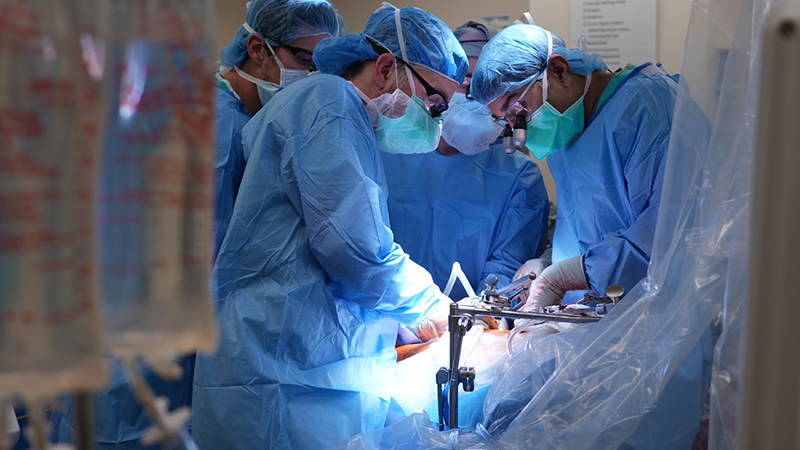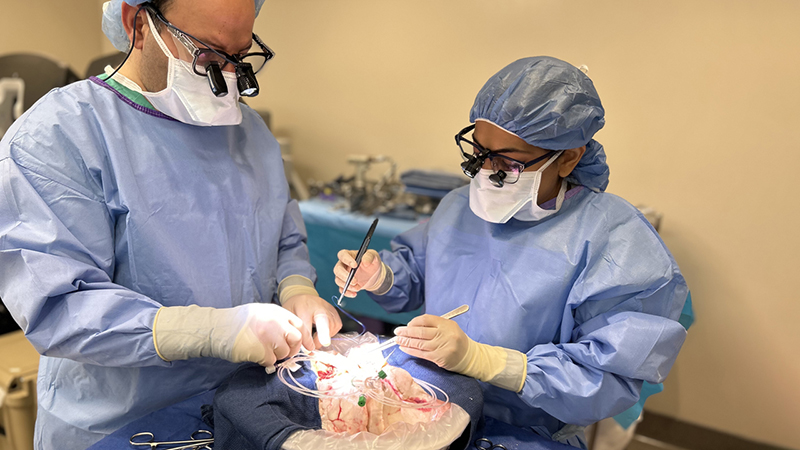Drill Gives Neurosurgeons Quicker and Safer Access to the Brain
A Northwestern University Student Invents a Surgical Tool
Published March 2024
Neurosurgery is one of the most advanced fields of medicine, but one neurosurgical tool seemed rudimentary to one student at Northwestern University.
While studying neuroscience as an undergraduate, Casey Qadir, the 24-year-old chief executive officer of Hubly Surgical, learned that ventriculostomies, a surgery involving drilling a hole into the skull to drain fluid, are typically performed using hand-powered drills. The device initially reminded her of primitive surgical tools one might see in a museum.
This drill offers greater levels of control and stability— Matthew Potts, MD
“I was surprised to learn about some of the antiquity that still exists in neurosurgery today. Possibly the most egregious example of that is the use of the hand-crank drill for emergency ventriculostomies,” says Casey. “At first glance, I thought the hand-crank drill looked medieval. So you can imagine my surprise when that turned out to be true. Hand-crank drills almost exactly like the ones used today have been used to form holes in the skull since the Middle Ages.”
In the U.S., medical professionals rely on the hand-crank drill for more than 60,000 procedures each year. During ventriculostomies, surgeons must act quickly to relieve pressure inside the skull due to serious conditions such as hemorrhage, traumatic brain injury, ruptured aneurysm or stroke. Given the urgency, patients cannot afford to wait hours for an operating room to become available, so the procedure is commonly performed in the intensive care unit (ICU) at patients’ bedsides.
Modernizing the Cranial Drill
In a graduate-level course called NUvention Medical offered by The Farley Center for Entrepreneurship and Innovation, Casey teamed up with neurological surgery residents Nikhil Murthy, MD, and Amit Ayer, MD, to form Hubly Surgical, and got to work to modernize the cranial drill.
“The biggest problem with hand-powered drills is they do not contain an automatic stop feature,” says Casey. “We know from one study that 66% of physicians experience plunging, which carries a 12% risk of death or permanent neurological morbidity. Another study shows that even in the hands of an experienced neurosurgeon, the risk for complication from manually drilling is 2%.”
To address these issues, Casey and her team developed a battery-powered drill with a variety of safety features. An auto-stop mechanism shuts off power to the motor as soon as the drill breaks through the skull. A cone-shaped drill bit also guards against over-penetration.
On the back of the device, a colored LED light turns green to let users know they are applying the correct amount of force, then changes to red when the device comes to a halt.
While the hand-crank drill requires two hands to operate, surgeons can use the Hubly Drill with a single hand, allowing them to place their free hand on the patient’s shoulder to stabilize them while drilling.
Implementing Advanced Technology at Northwestern Medicine
A Northwestern Medicine neurosurgeon was the first physician in the U.S. to successfully use the new neurosurgical drill to save the life of a patient in the ICU. The emergency procedure took place in October 2023 at Northwestern Memorial Hospital when Neurosurgeon Matthew Potts, MD, used the Hubly Drill to create a hole in the skull of a patient with a brain bleed. After inserting a catheter through the hole, Dr. Potts was able to drain excess cerebrospinal fluid from the patient’s brain, relieving pressure inside the skull and ultimately saving the patient’s life.
This procedure took only 15 seconds, far faster than the hand-crank drill. It was also more accurate and safer.
“This drill offers greater levels of control and stability, and its ease of use is especially beneficial for our residents and fellows who are still learning the procedure,” says Dr. Potts. “In addition to how innovative this technology is, I think it’s wonderful to see Northwestern University students and residents coming together to create something that, years later, is now poised to have a huge impact on the field of neurosurgery.”
Bench to Bedside: Coming Full Circle at Northwestern Medicine
“It’s incredibly meaningful that being founded out of Northwestern University, Northwestern Medicine also got to be the first place where we had impact on the patient population and the users that inspired us to fix the problem in the first place,” says Casey.
Learn more about Northwestern Medicine Neurosurgery.






